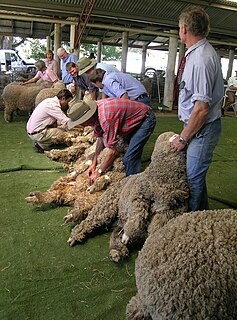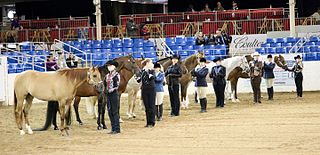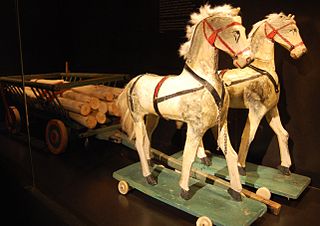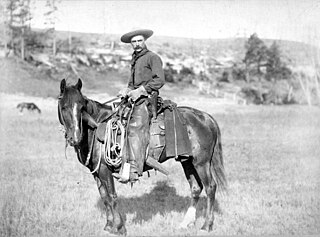
The American Quarter Horse, or Quarter Horse, is an American breed of horse that excels at sprinting short distances. Its name is derived from its ability to outrun other horse breeds in races of a quarter mile or less; some have been clocked at speeds up to 55 mph (88.5 km/h). The Quarter Horse breed began when colonists in the 1600s on the Eastern seaboard of what today is the United States began to breed imported English Thoroughbred horses with assorted "native" horses. This included the Chickasaw horse, which was a breed developed by Native American people from horses descended from Spain and brought to the United States by the Conquistadors. These horses were developed from Iberian, Arabian and Barb stock brought to what is now the Southeastern United States.

Horse breeding is reproduction in horses, and particularly the human-directed process of selective breeding of animals, particularly purebred horses of a given breed. Planned matings can be used to produce specifically desired characteristics in domesticated horses. Furthermore, modern breeding management and technologies can increase the rate of conception, a healthy pregnancy, and successful foaling.

A horse show is a judged exhibition of horses and ponies. Many different horse breeds and equestrian disciplines hold competitions worldwide, from local to the international levels. Most horse shows run from one to three days, sometimes longer for major, all-breed events or national and international championships in a given discipline or breed. Most shows consist of a series of different performances, called classes, wherein a group of horses with similar training or characteristics compete against one another for awards and, often, prize money.

The Tennessee Walking Horse or Tennessee Walker is a breed of gaited horse known for its unique four-beat running-walk and flashy movement. It was originally developed in the southern United States for use on farms and plantations. It is a popular riding horse due to its calm disposition, smooth gaits and sure-footedness. The Tennessee Walking Horse is often seen in the show ring, but is also popular as a pleasure and trail riding horse using both English and Western equipment. Tennessee Walkers are also seen in movies, television shows and other performances.
A breed registry, also known as a herdbook, studbook or register, in animal husbandry and the hobby of animal fancy, is an official list of animals within a specific breed whose parents are known. Animals are usually registered by their breeders while they are young. The terms studbook and register are also used to refer to lists of male animals "standing at stud", that is, those animals actively breeding, as opposed to every known specimen of that breed. Such registries usually issue certificates for each recorded animal, called a pedigree, pedigreed animal documentation, or most commonly, an animal's "papers". Registration papers may consist of a simple certificate or a listing of ancestors in the animal's background, sometimes with a chart showing the lineage.

A livestock show is an event where livestock are exhibited and judged on certain phenotypical breed traits as specified by their respective breed standard. Species of livestock that may be shown include pigs, cattle, sheep, goats, horses, llamas and alpacas. Poultry such as chickens, geese, ducks, turkeys and pigeons are also shown competitively. A livestock show may be part of an agricultural show.

Hunt seat is a style of forward seat riding commonly found in North American horse shows. Along with dressage, it is one of the two classic forms of English riding. The hunt seat is based on the tradition of fox hunting. Hunt seat competition in North America includes both flat and over fences for show hunters, which judge the horse's movement and form, and equitation classes, which judge the rider's ability both on the flat and over fences. The term hunt seat may also refer to any form of forward seat riding, including the kind seen in show jumping and eventing.

Showmanship is an event found at many horse shows. The class is also sometimes called "Fitting and Showmanship", "Showmanship In-Hand", "Showmanship at Halter" or "Halter Showmanship" It involves a person on the ground leading a horse, wearing a halter or bridle, through a series of maneuvers called a pattern. The horse itself is not judged on its conformation. Rather, the exhibitor is judged on how well he or she exhibits the animal to its best advantage, with additional scoring for the grooming and presentation of both horse and handler.

Model horses are scale replicas of real horses. They originated simultaneously—but independently—in the USA, Canada, and the UK, followed later by Sweden (UK-influenced), Germany (US-influenced), Australia. They encompass a wide variety of fanbase activities, from those who simply like to collect, to those who enthusiastically show their models at model horse shows. Unlike model cars or trains, model horse collectibles do not need to be assembled from kits, although they can be altered to the collector's liking.

Western riding is considered a style of horse riding which has evolved from the ranching and welfare traditions which were bought to the Americans by the Spanish Conquistadors, as well as both equipment and riding style which evolved to meet the working needs of the cowboy in the American West. At the time, American cowboys had to work long hours in the saddle and often over rough terrain, sometimes having to rope a cattle using a lariat, also known as a lasso. Because of the necessity to control the horse with one hand and use a lariat with the other, western horses were trained to neck rein, that is, to change direction with light pressure of a rein against the horse's neck. Horses were also trained to exercise a certain degree of independence in using their natural instincts to follow the movements of a cow, thus a riding style developed that emphasized a deep, secure seat, and training methods encouraged a horse to be responsive on very light rein contact.

Breyer Animal Creations, is primarily a manufacturer of model horses. Founded in 1950, the company, now a division of Reeves International, Inc, specializes in model horses made from cellulose acetate, a form of plastic, and produces other animal models from the same material as well. Less well known are its porcelain horse figures, which are aimed at the adult collector market. The company also produces model tack accessories and horse-related structures, such as stables, barns, and grooming implements in scale to its model horses.

Halter is a type of horse show class where horses are shown "in hand," meaning that they are led, not ridden, and are judged on their conformation and suitability as breeding stock. Depending on breed and geographic region, such events may be called "Halter," "In-Hand," "Breeding," "Model," or "Conformation" classes.

The show hack is a type of ridden show horse, exhibited to a standard first established in England.

The National Snaffle Bit Association (NSBA) is an equestrian organization in the United States that began by promoting and staging Pleasure riding events. Since then, several more disciplines have been added. It was founded in 1983. It is currently headquartered in Gurnee, Illinois, United States. The NSBA has a partnership with the American Quarter Horse Association (AQHA) in order that both associations can benefit from the many rules and regulations they have in common.

Khemosabi (1967–2001) was a bay Arabian stallion with four stockings and a blaze, who had significant accomplishments in the horse show ring, winning multiple National Championships in both halter and western pleasure performance competition. These wins earned him the highest level achievement award offered by the Arabian Horse Association: the Legion of Masters. In the course of his breeding career, he sired over 1200 foals. Of these, over 300 were show champions and 75 won national championships.

This is a basic glossary of equestrian terms that includes both technical terminology and jargon developed over the centuries for horses and other equidae, as well as various horse-related concepts. Where noted, some terms are used only in American English (US), only in British English (UK), or are regional to a particular part of the world, such as Australia (AU).
Magnum Psyche is a chestnut Arabian stallion foaled May 2, 1995. He is sired by Padrons Psyche and out of A Fancy Miracle. His grandsires are *Padron and *Sasaki. He is owned by the Haras Mayed stud near Buenos Aires Argentina, which is owned by Fernando and Joaquin Santibanes. For many years he has stood at stud in the United States and is closely associated with the trainer David Boggs.

For the plant horsetail see Equisetum.
Poco Pine (1954–1974) was an American Quarter Horse stallion and breeding stallion. He earned 50 Grand Championships in his showing career and after his death was inducted into the American Quarter Horse Association's AQHA Hall of Fame in 2010. Two of his descendants have also been inducted into the AQHA Hall of Fame. 37 of his offspring earned an AQHA Championship during their own showing careers.

GTR Patricks Vindicator is a registered American Miniature Horse gelding, foaled in South Carolina at GTR Mini Ranch. He is most commonly known as "Patrick" or "Patrick The Miniature Horse". He is a sorrel, with one blue eye (left), a blaze, and a coronet with white hoof. He measures at 33.5 inches tall, and is registered with the American Miniature Horse Association (AMHA) and the American Miniature Horse Registry (AMHR) He was purchased by Byrd's End Farm on July 4, 1998, and has been located in Shepherdsville, Ky ever since. He now competes at sanctioned and non-sanctioned Miniature Horse shows, performs therapy work and exhibits at notable events across Kentucky.















